|
Buses & Trams
The E.C.C. (originally the Electric
Construction Corporation Limited) was formed in 1889 by
the amalgamation of Elwell-Parker Limited, the Elecrical
Power Storage Company Limited, and the Railway
Electrical Contractors Limited. The new concern was incorporated on 7th June,
1889, and a new factory costing £10,000 was built on a 24.5 acre
site, previously acquired by Elwell-Parker Limited at Bushbury. When building work was complete, the staff and
machinery from the Elwell-Parker factory at Commercial Road,
Wolverhampton were moved to the new site.
Thomas Parker from Elwell-Parker
Limited became Works Manager, and J. E. H. Gordon, who was well known for his work on
connection with the early electric lighting at Paddington Station
became the corporation's engineer. Things got off to an excellent start
under the chairmanship of Sir Henry Mance, with the works operating
at full capacity and orders flooding-in. |
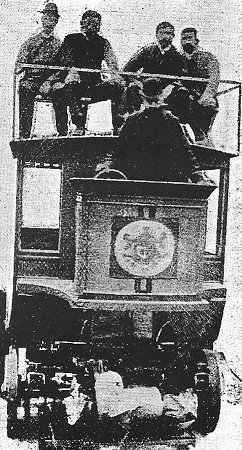
The only existing photograph of one of the
E.C.C.'s 26 seater omnibuses. Courtesy of the late Jim Boulton. |
The corporation's first vehicle project was a
battery-powered tramway system built for Birmingham
Tramways, to update the existing steam operated system.
This followed the successful trial in 1888 of an Elwell-Parker
prototype battery-powered tram, which ran on their
existing system, and out-performed the steam trams.
Unfortunately the lead-acid batteries were placed under the
passenger's seats, and a portion of the gross profit was absorbed in
the settlement of claims from passengers, whose clothing had been
splashed by acid.
In 1891, two E.C.C. 26-seater
omnibuses began running in London, from Charing Cross to Victoria Station.
They had iron-tyred, wooden wheels, and were powered by 72
lead-acid batteries. Each of the two axles was chain-driven, by
its own large electric motor.
The omnibuses were designed by W. C. Bersey, and weighed around 3.5 tons. There was room for
twelve people inside and 14 on top. Thomas Parker's son, Thomas Hugh Parker assisted
in the construction of the buses. |
| Several single-decker buses were also built for
the London Electric Omnibus Company, which were battery powered,
had steering and hydraulic brakes on all four wheels, and seated
14 people. |
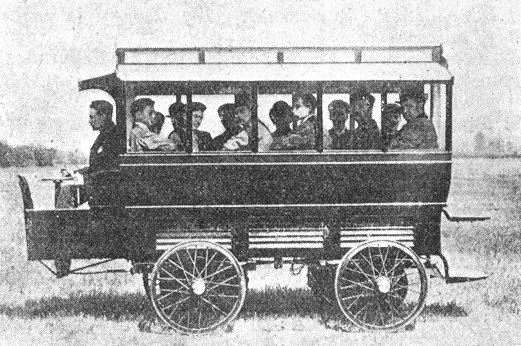
A battery-powered 14 seater bus, with 4 wheel
steering. |
E.C.C. also developed an overhead-wire, tram system,
which was put to use in 1893 when the company
electrified the South Staffordshire Tramways, and a
little while later the Hartlepool tramway. Thomas Parker
laid-down a section of tram-line at the works, which he
hoped would be largely copied in London for direct
tram-driving.
|
The following description of the tramway
is from the Railway Engineer, volume 14,
number 1, January, 1893:
The South Staffordshire Tramways have an
aggregate length of about 23 miles. They
connect Darlaston, Wednesbury, West
Bromwich, Handsworth, Great Bridge, Dudley
Port, Dudley, Walsall, and Bloxwich with
each other, and last year 4,000,000
passengers were carried.
About nine miles-viz., from Darlaston and
Wednesbury to the Pleck, thence to Walsall
Bridge, where the line again separates, one
branch going to Bloxwich and the other to
Lichfield Road - has been fitted to work by
electricity upon the over-trolley wire
system.
The installation has been carried out
entirely by the Electric Construction
Corporation of Wolverhampton. The
sub-contractors for the cars were the
Lancaster Carriage and Wagon Co., and Brown,
Marshalls & Co., for the stationary engines
and boilers of 150h.p. Messrs. Musgrave &
Son, of Bolton, and the posts to carry the
overhead wire were divided between Messrs.
James Russell & Sons and Messrs. John
Russell & Co.
The motors are of the Elwell-Parker type.
The posts are placed at the side of the
road, and the bracket arms carrying the
trolley wire stretch out over the road 7 to
10ft., but give a clear height of 21 ft. By
a kind of universal joint the collector is
allowed a variation of several feet, so that
it is not necessary for the trolley wire to
be directly over the middle of the line. |
|
|
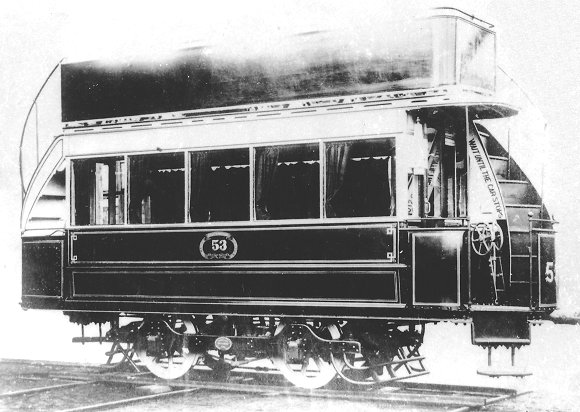
A South Staffordshire Tramways
tram. |
The South Staffordshire Tramways depot, and company headquarters was
situated in Corns Street, off Birmingham Street,
Darlaston.
The installation was carried out by E.C.C., and
all of the electrical equipment was designed by the
company's chief design engineer Thomas Parker. |
| The tram motors were of the Elwell-Parker type and
built by E.C.C.
The tramway had an electricity generating station at
the Pleck, on Walsall Road, just outside Darlaston, with
electrical generating equipment designed by Thomas
Parker. |
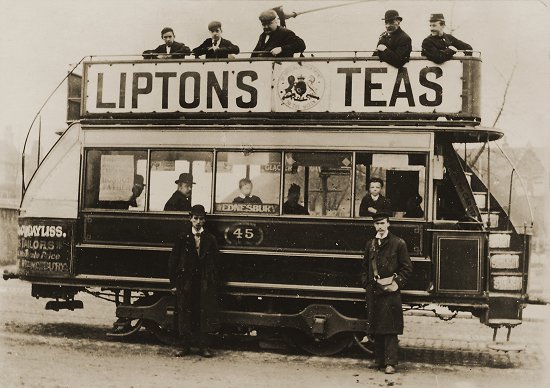
Another South Staffordshire
Tramways tram. |
|
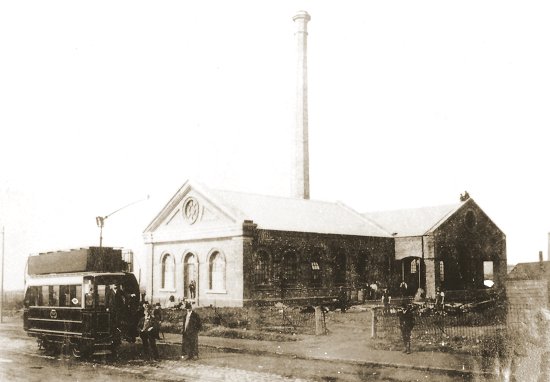
The South Staffordshire Tramways
electricity generating station.. |
The trams, in their oak brown and cream livery,
became a familiar sight around Walsall and Darlaston,
and were a great success. In the first year around 4
million passengers were carried.
The trams continued in use until the South
Staffordshire Tramways Company Limited ceased to operate
in 1924. |
| ECC also produced other trams including a 52 passenger
tramcar for the Bournemouth Tram Depot. |

An E.C.C. accumulator
locomotive. |
The new company found itself in deep trouble and
was voluntarily wound up in July, 1893. It seems
that there was a lot of dissent amongst the Board of
Directors, one of whom later was convicted of fraud.
The company was reconstructed as the Electric
Construction Company Limited. Sir Daniel Cooper
became Chairman, and
Mr. P. E. Beachcroft, J. W. Barclay and J. Irvine
Courtenay joined the Board. The Company Secretary
was Mr. James Gray and Mr. Emile Garcke joined the
Board to be responsible for the reconstruction of
the commercial side of the business. |
 |
Return to the
list
of manufacturers |
|